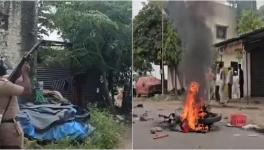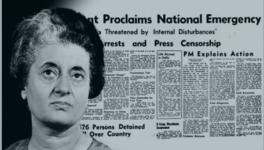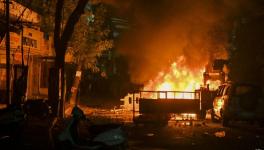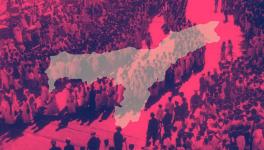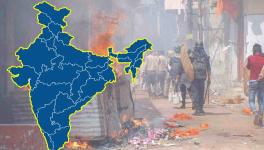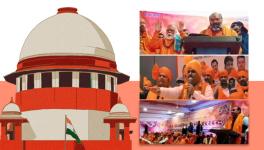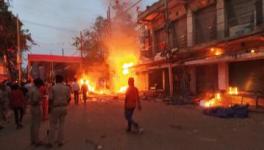Nellie 1983 Revisited: Victims Say They Had Been Barricaded for 6 Months Before the Massacre
Romisa Khatun was running aimlessly with her one-and-a-half-year-old son hanging on to her waist. Suddenly she felt a sharp, stabbing pain on her chest. It was a spear that had pierced through her chest, making a hole through the body, penetrating the bones, the muscles — coming out on the back of the body. Blood gushed out and she lost her senses.
Days after, she woke up at a hospital and asked for her child, but it was too late. She had lost the child; her one-and-a-half-year-old son had been killed. Romisa was 18-year-old back then on the ‘Black Friday’ of February 18, 1983, when the 8-hour-long Nellie Massacre took place in central Assam's Nagaon district (now Morigaon). The carnage is estimated to have left over 5,000 people dead, including the elderly and children. The official reports, however, put the death toll at only 1,819.
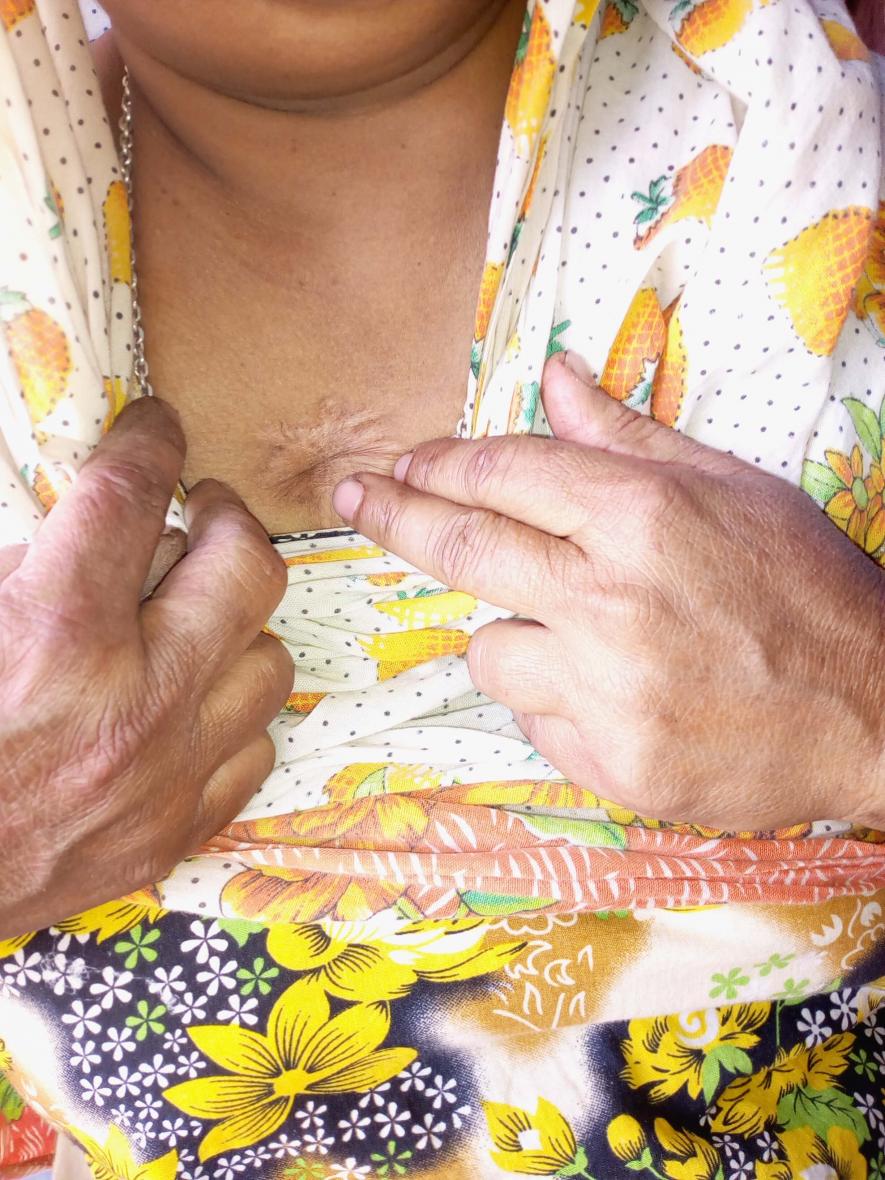
Romisa Khatun shows the scar on her left by the spear.
Now Romisa is 54, but the wound with loose skin hanging around the dent on her chest -that left a hole not just through her body but her mind too, still remains a grim reminder of the massacre that left thousands of people scarred.
The Background of the Nellie Massacre and Assam Agitation
The Nellie Massacre was one of many that happened during the Assam Agitation which started in 1979 and ended in 1985. In 1979, the All Assam Students’ Union (AASU) launched a statewide agitation to evict the alleged Bangladeshi immigrants from the state.
In March 1979, Hiralal Patowari, MP from Mangaldoi, died, and it was necessary to hold a by-election. By the time, the Election Commission (EC) had started reviewing the electoral rolls of Assam amid AASU’s allegation of massive influx of Bangladeshis in the state. The EC's assessment also showed that 45 thousand 'illegal foreigners' were listed in the electoral rolls. Meanwhile, the then Golap Borbora-led Janata Party government of Assam also collapsed, thus necessitating state assembly elections as well. AASU’s campaign against alleged Bangladeshi immigrants and their expulsion from the voter lists gained momentum now because of the imminent state polls. The Prafulla Kumar Mahanta-led AASU now demanded that until and unless the electoral rolls were completely revised, no election should be held in Assam.
Also Read: Playing With Fire: The BJP May Have to Watch the Northeast Burn
Meanwhile, going against the popular sentiments of the Brahmaputra valley, then Prime Minister Indira Gandhi on February 2, 1982, announced to hold elections in the state in the same month. This propelled the Assam Agitation or the Assam Movement to get violent at places, and massacres followed one after another. Anyone who voted was considered Bangladeshi, and so the killing spree of Nellie, Chawolkhowa, Gohopur — among many massacres, followed.
Most of the available literature say that the Nellie Massacre was the direct fallout of the elections held on February 14 and 17, 1983. Diganta Sarma, a renowned journalist working with the Assamese daily Sadin, wrote in his famous book Nellie, 1983, that the plan to attack the villages in Nellie had been made after a few Muslims voted on February 14, going against AASU's call for boycotting the vote all over the state. The boycott call was given demanding total revamping of the voter lists after the then PM Indira Gandhi had decided to give millions of alleged immigrants from Bangladesh the right to vote.
However, the narrative might have been different in the case of Nellie, so far as a new revelation is concerned — that villagers on the Nellie ground zero had literally been held captive for about 6 months, indicating a much bigger game plan for Nellie.
The 6-Month-Long Blockade Before the Massacre
Romisa Khatun, like hundreds others in the Muladhari village, about 4 kilometres from Nellie or National Highway No. 37, already knew that they would be attacked. Only they did not know it would be that Friday. Musabbir Ali, 55, remembered, "The local Assamese sympathisers told us a few days before the attack that you should try to flee the area at the earliest possible — as the preparation for an attack is on."
However, no villager —including Musabbir and Romisa — had actually anywhere to go — as they had virtually been held captive for about 6 months before the massacre actually happened. At least three of the Muladhari villagers, including Musabbir, confirmed about the 6-month-long barricade that did not allow them to move anywhere. All roads to the outside world were literally cut off. It was a meticulous plan to execute them.
"But we couldn't go anywhere. We had been barricaded from all sides. The roads were closed off for us from all sides. Even if we had tried to go to the roads, they would have killed us. There was no way out for us. We were living in a ghetto, a swamp, cordoned off from all sides," added Musabbir.
Answering the question as to how long the roadways had been closed off for them, Musabbir said, "It was, I think a year, since the incident happened."
Musabbir went on saying, "At Nagaon's Bebejia, people had been dragged out of the vehicles and been killed."
Musabbir's claim of a year-long barricade, however, does not seem to be accurate, as Noor Ahmed, an Assamese Muslim, who served as the Imam of a mosque at Muladhari during the tense 80s, said. "Yes, they were barricaded, but it was not for a year; it should be 6 months before the massacre that they had started barricading the area.”
Ahmed, in his 70s now, who served as a local pharmacist as well in Muladhari, said he went to his home at Morigaon district's Tokunabori village to see his ill daughter. The local Assamese people, however, had not harassed him at all, as they depended on him for medicine. On the day of the massacre, however, he said the attackers didn't leave him. "The attackers were mostly outsiders, not the local folks. So, they attacked me too, without recognising. I tried to save two young girls as well, one with a kid on her lap. They came to me pleading, 'please save us'. I knew both of them as my ex-students from the mosque. When the attackers started firing gunshots and arrows, an arrow pierced through my neck. I still have the mark of the wound. One of the girls, the one with a kid, was shot and fell into the Kiling river. I could not save her," said Ahmed.
As Ahmed said, the Nellie villages had been already barricaded for nearly six months before the massacre. This has been confirmed by a woman of the Muladhari village too. Rahila Khatun, who is around 60 years old, describing their plight during the blockade, said, "We couldn’t go to the markets. We had a lot of problems gathering the food. We could hardly feed ourselves then. We couldn’t even purchase the daily grocery from the local shops….they stopped giving us grocery items on credit after a while. There were the Dharamtul and Nellie markets, but we couldn’t go there. There were no other markets around. Moreover, we were barred from going to the markets. On some days, when we could grab some rice, we would cook the rice and would eat the food without any curry, mixing only salt."
On asking how long they faced the blockade, Khatun said, "We ate like that for about 6 months. On that fateful day itself, we had to leave the cooked rice on plates, half-eaten. Didn’t have the time to finish eating."
Another villager, 65-year-old Awal Uddin, confirming about the 6-month-long barricade, said, "Yes, they literally blocked all communication with the outside world for us since sometime back in 1981.
At least three people claimed that the blockade lasted about 6 months till the day of the massacre, while one said it was a year-long blockade. This changes the narrative of the Nellie Massacre somehow. The testimonies prove that the game plan had been made at least 6 months before the actual massacre.
Memories of a Massacre…
"We kept running for 3 days without any food or water to drink. We went to the fields, looking for some water from the nearby marsh to drink some water. But the water was all red with the blood of those butchered people. It was not possible to drink that bloody water….At last, blood came through our dry mouth…we literally coughed blood," remembered Rahila Khatun, one of the few survivors from Muladhari.
Musabbir Ali’s 75-year-old mother Saimun Nessa also remembered how she lost two of her boys. "I was carrying my 6-month-old boy, hanging onto my waist. When the attackers came, we started running helter-skelter, aimlessly. Then I jumped into the Kopili river to save life. I told my two other sons to hang onto my clothes, but the river washed them away. I never got their bodies," said Nessa.
"My father-in-law, mother-in-law, sisters-in-law, I lost a lot of people," added Nessa while wiping tears off her face. Musabbir also said that they lost about 60 people from their extended family in the carnage.
Khatun had an even more horrific tale to tell. "Some even left their children to die, even telling the others, 'You better save your lives. If you live, you can have more children," she said, describing the helpless situation that had been forced on the victims.
"Listening to that, some left their kids sitting alone to die, while some ran away, carrying their children along," added Khatun.
The Bureaucratic Failure
The cops also knew about the plan already at least 3 days prior. Diganta Sarma wrote in his book, "That there will be a massacre in the Nellie area had already been known to the police and the home department bureaucrats. The proof of that finds ground in the fact that Jahiruddin Ahmed, then Nagaon Police Station's officer-in-charge sent an urgent message to Morigaon's 5th Battalion's commandant, the sub divisional police officer and Naba Chetia, the officer-in-charge of the Jagiroad police station. However, none of the officials took the message seriously."
Diganta further wrote, "The Nagaon Police's message sent to the officer-in-charge of Jagiroad Police Station and commandant of the 5th Battalion of Morigaon reads as:
To,
CO, 5th AP,
INFO, O/C J/Road, PS, SDPO(M). .
From, O/C NWG PS, Dt. 15.02.83.
INFORMATION RECEIVED THAT L/NIGHT ABOUT ONE THOUSAND ASSAMESE OF SURROUNDING VILLAGES OF NELLIE WITH DEADLY WEAPONS ASEMBLED AT NELLIE BY BEATING DRUMS (.) MINORITY PEOPLES ARE IN PANIC AND APPREHENDING ATTACK AT ANY MOMENT 9 (.) SUBMISSION FOR IMMEDIATE ACTION TO MAINTAIN PEACE (.)".
Many literature on the Nellie Massacre prove that the police had utterly failed to stop the massacre from happening. There were allegations against the local cops even of participating in the massacre. However, the big question that still remains hanging is: Who made such a huge, meticulous plan and started executing it about 6 months before the massacre? Was it only AASU, or was it the Rashtriya Swayamsevak Sangh (RSS) — and to what extent?
The RSS Involvement with AASU, Assam Agitation and February Massacres
While the Sangh had only one shakha (branch) in Guwahati back in 1946, by 1975, it had shakhas in every district of Assam. In a book published in 2017 by RSS ideologue Rajat Sethi and Shubhrastha, The Last Battle of Saraighat: The Story of the BJP’s Rise in the North-east, the authors wrote, "By 1975, all districts in Assam had Sangh shakhas. The gradual brick-by-brick establishment of the Sangh in Assam has been a result of decades of perseverant work and selfless service by swayamsevaks from all across the country."
Also Read: Will Assam Burn While BJP Fiddles With the Citizenship Bill?
In another article published in an Assamese magazine Fasal (Harvest), Dr. Hafiz Ahmed, an educationist and writer, wrote that before the Assam Agitation, the RSS did not have much influence in the state. He wrote, "It was during the Assam Agitation that the Sangh could grow its tentacles and make its roots stronger. In 1983, there were 300 shakhas of the Sangh. In the Nagaon district itself, there were 200 active workers. During the Nellie attack, the way songs had been written and singers were brought to sing for the 'Brave Soldiers' (?) to inspire them, the way they deployed a nurses' force to aid in case any attacker gets injured are clear indications of the involvement of the Sangh, which has this kind of expertise in organising communal riots."
In a sub chapter titled "The Assam Movement and the Remoulding of the RSS", written by the RSS ideologues, the authors described the way the Sangh had used the Assam Agitation era as an opportune moment. "In the beginning, it was neither a potent ideological force in Assam nor did it manifest itself in any political inclinations and interests. However, the sociopolitical–cultural contours of time that opened up in Assam and the nation at large during the late 1970s–80s prised open an opportunity for the RSS to assert its ideological commitments," the book reads.
The chapter elaborately described the way the RSS 'moulded' the Assam Agitation. "It was the time when the anti-foreigner movement was at its peak in Assam and under the commitment to Hindutva, the RSS found a way to assert itself beyond the sociocultural activities it had engaged in", the authors wrote.
It further says, "The RSS first transformed the agitation from being anti-bahiragat (outsiders) to being an anti-videshi (foreigners) movement. In gradual course of time, the sentiments were further directed against the immigrant Bangladeshis and later against the Bangladeshi Muslims. The question of saving the state’s identity from the onslaught of foreign migrants echoed the nationalist and protectionist sentiment of the RSS."
Joynath Sarma's Alleged Involvement With RSS
Although the Assam Agitation against the alleged foreigners was being led mainly by two organisations — AASU and All Assam Gana Sangram Parishad (AAGSP), there was another organisation under the umbrella of AASU and AAGSP called the All Assam Volunteers Force, headed by Joynath Sarma. There had been allegations against him from inside AASU about his alleged links with the Sangh that led AASU to be divided in almost two camps on communal lines. Incidentally, Sarma's brother Dayanath Sarma was killed on February 15, while attacking the Bengali Muslim and Hindus at Chawolkhowa Chapori, where another massacre left about 1,000 people killed. This proved AASU’s involvement in the massacres.
Also Read: BJP’s Politics in Assam Post-CAB: Communal Division, Aberration of Facts
Assamese journalist Diganta Sarma told this correspondent in an audio interview that Joynath Sarma had been expelled from AASU later, owing to the allegations of his involvement with the RSS. At Chawolkhowa, most of the victims were Bengali Muslims, showing that the attack was communal in nature. The RSS clearly supported and 'moulded' the agitation, and maybe the AASU leadership as well. India Today had published an article written by Arun Shourie and Swagata Sen, which said, "The All Assam Students' Union (AASU) is believed to have played a very active part in the massacre…."
The unpublicised Tiwari Commission report, which still remains a closely guarded secret, also blamed AASU and the Bharatiya Janata Party among others for the violence unleashed on the alleged Bangladeshi people. It said, "The circumstances leading to the disturbances which took place during January to April, 1983 were provided by the fact that when it was decided to hold the general elections, certain sections of public instigated by AASU/AAGSP and political parties like, BJP, Janata and Lok Dal and some anti-social elements decided to boycott the election and even resorted to violence to further their objective."
The Tiwa Community’s Involvement
The 14 villages where a carnage was unleashed on the fateful Black Friday, are surrounded by the Tiwa and Lalung communities. Cases against many of them had been filed, which means they were involved in the massacre. Without local participation, the attack couldn’t have been possible. Diganta Sarma’s book throws some light on their involvement. "Some of the local leaders were found repenting for the massacre. Some of the people said they were provoked by passion and excitement, which led them to a killing spree that day. Some of the Tiwas opined that it was AASU and AGSP who organised the massacre and engaged the Tiwas to annihilate the alleged Bangladeshi infiltrators. Some of the Assam Agitation leaders got the ethnic people involved by bringing them out of their houses. To organise such an enormous massacre, the involvement of the local folks is quite important in this regard. But the AASU and AGSP later denied all allegations of being involved at all in the event. They instead blamed only the Tiwas for the carnage, which precisely means the Tiwas were used as shields for their misdeeds….That’s why the Tiwas were bound to quit their alliance with AASU and later formed the All Tiwa Students' Union in 1989," wrote Sarma.
Recently on February 17, 2019, when a local NGO-cum-Assamese daily Gana Adhikar, observed the Nellie Day, Narayan Kumar Radu Kakoti, the founder and the first chief executive member of the Tiwa Autonomous Council, clearly said, "This had not been done by the Tiwas alone. This place is surrounded by the Tiwas, the Lalung tribal people, and that’s why the Lalungs have been blamed. You should know that it was some of the leaders of the Assam Movement, as well as the RSS-influenced people, who did this." Kakoti was a college student back in 1983 when the Nellie Massacre happened. He said he was away from home for studies and that when he came to know about the massacre, he felt extremely sad.
688 Cases Closed; Nellie Victims Await Justice
Nobody knows who is to be blamed for one of the worst massacres in the history of India. The RSS offshoot BJP is in power both in the centre and the state now, while the current leadership of AASU, claiming to be secular enough to lock horns with the BJP government over the Citizenship (Amendment) Bill issue, is busy once again to throw out illegal immigrants from Assam. Meanwhile, the 1980s’ AASU leaders have been rejected by the people of Assam in their metamorphosed form of Asom Gana Parishad (AGP), while the Nellie victims and their kin who survived the massacre, are still awaiting justice.
Also Read: The Citizenship Bill and the Resurgence of the Rising Sun
After the massacre, 688 FIRs were filed in the local Jagiroad Police Station. Charge sheets were also filed after investigating 310 of the cases. The rest of the 378 cases still remain pending, while all the cases were closed off later. The people of Nellie who lost everything and have received nothing, are still facing discrimination. The 10–15 km-long earthen dam, which goes from the Dharamtul area to Amlighat through Muladhari village, was constructed in 1960, as a villager said, and still awaits to be made into a concrete road. Around 65-year-old Awal Uddin, a survivor of the massacre, said, "Indira Gandhi herself had told us the road would be concreted. But it never happened."
So, Nellie still awaits justice, as Musabbir's 75-year-old mother Saimun Nessa, who lost two of her boys in the massacre, keeps on saying, "What did we get, what did we? We got nothing,” while Musabbir murmurs, "Those who killed us got Rs 5 lakh, and we didn’t receive even Rs 5,000."
The government, although had doled out a pittance of Rs 5 to 10 thousand to the kin of all those killed, it seems some were missed. Meanwhile, 36 years have passed, people gather at Nellie to observe the day, dignitaries are invited, but not a single villager is called to the makeshift stages to narrate what they faced or what they are still facing.
Inside her bamboo-made home, Saimun Nessa keeps on crying for her sons killed 36 years ago, or Romisa Khatun continues living with the spear wound on her chest. There is nobody to blame any more. So they have forged a tryst with their destiny by now, saying, "We suffered a lot. Allah had kept pain for us, but we are not unhappy. We rather give thanks to Allah that we could witness such a thing happening in our lifetime."
Read More: The Citizenship Amendment Bill, Assam Accord and the People of Assam
Get the latest reports & analysis with people's perspective on Protests, movements & deep analytical videos, discussions of the current affairs in your Telegram app. Subscribe to NewsClick's Telegram channel & get Real-Time updates on stories, as they get published on our website.











